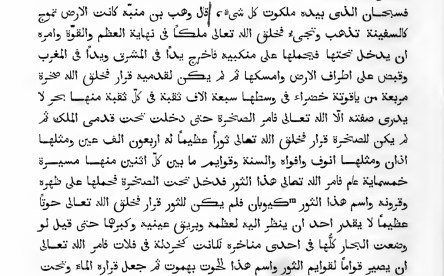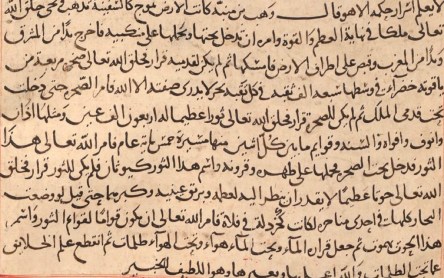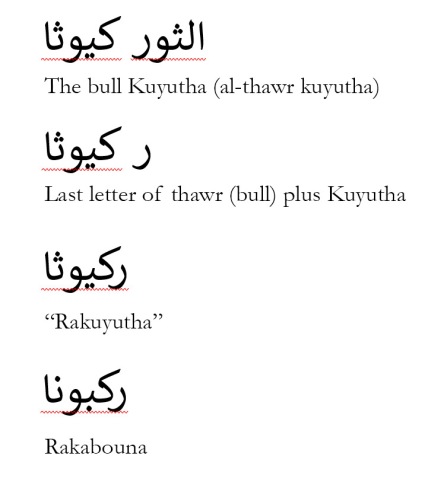I have been requested (by someone who I hire to request) to explain how, exactly, something like “Leviathan” could end up misread and corrupted into “Kuyūtha” or even “Rakaboûna”. And I’m sure there are some people out there (presumably countable on one hand missing several fingers) who are interested in etymology, language, and how monsters evolve based on those.
Well, fear not, for here’s where it gets technical.
Arabic is tricky to read. Why? Well, for a start there’s different ways of writing it, different types, texts, font sizes (as it were). Look at this, for instance.

Nice and legible text, modern printing of al-Wardi. Easy peasy. Then you get older copies like this version of al-Qazwini.

Slightly less legible, but still readable. But then you get to this version of al-Damiri, and, well, you need to see the whole page to get the full impact.

Your eyes aren’t deceiving you. The text in the box is al-Damiri. The text in the margins is the Wonders of Creation by al-Qazwini. That’s right, two books for the price of one, all in lovely tiny crabbed handwriting!
And then of course there’s the lovely manuscripts with the flowery text which I can barely decipher.

Let’s put those aside for now and stick to more legible things.
The next issue is the language itself. There are few vowel letters in Arabic. Most vowel sounds are represented with diacritics.
And guess what? Most times they don’t even write the diacritics! So just based on that, Kuyutha, Kiyutha, Kayutha, Kuyuthan, Kayuthan, Kiyuthan are all equally valid based on the vowels assigned. The “an” at the end can be either a letter or a diacritic – if it’s a letter it’s definitely there, if it’s a diacritic it’s debatably there.
Not only that, but based on the quality of the writing, K and L can look identical, Y and B can look identical (hence Kuyuban), T and TH and N can look identical… So combine that with the average vowel movements (haw haw) and you can piece together how Leviathan could get garbled into Kuyūtha.

“But what about Rakaboûna?” I hear you say. “You even describe it as “hilarious but understandable” in your entry!”
Well, yes. Yes it is. This misreading is unique to Perron, and he attributes his translation to al-Damiri, which you may remember as being teeny-tiny-textual. I’ll admit I couldn’t figure out how he got “Rakaboûna” out of “Kuyūtha”, until I saw it in context and it all made sense. Here’s the actual part:

I’ve highlighted “and the name of the bull [is] Kuyūtha”. See how cramped the text is? Turns out Perron glued the last letter of “bull” (thawr), which is an R, to the name of the bull. Then he proceeded to read the Y as B and the TH as N, giving “Rakaboûna”. Here’s how the magic happened:

And there you have it. The poor cosmic bull got saddled with increasingly bizarre monikers, when in reality it should have just been called Behemoth, poor bovine.
I don’t speak Arabic but that’s super interesting! I hope it would be featured in your book, if you were to publish one.
LikeLiked by 1 person
This is so interesting! I know nothing whatever of Arabic but you’ve explained it so clearly that I can actually follow along anyway. Thank you 🙂
LikeLiked by 1 person
interesting how the lore and descriptions of monsters change over time. therefore, I feel interested in mythical creatures and mythology trying to understand the moral idea and origin behind the myth is what I enjoy the most because it tells so much about such cultures. greeting my friend! keep up the good work, it always makes my day to see your posts.
LikeLiked by 1 person
This is fascinating. Your knowledge really is a treasure. Thanks again !
LikeLiked by 1 person
This was an interesting lesson. The box was placed in by the modern publisher, correct?
I’m starting to like the idea of having Behemoth being baby Kyutha,like a progenitor of some sort. A lesser reflection of the bigger whole, like man as the Big G’s tiny people.Like the goast of Shub being her children.
LikeLiked by 1 person
This is so interesting and exactly what I’m interested in. You can’t be interested in mythology and monsters without diving into the world of language and etymology.
LikeLiked by 1 person
language is hard in general.
LikeLiked by 1 person
I wish I learned language in college instead of science 😦
LikeLike
I am definitively interested in both language and monsters, and I loved this entry.
LikeLiked by 1 person
In the Tafsir of Ibn Abbas (a companion of the Prophet Muhammad), the name of the whale is Lutiaya (لوتيا).
Lotan became Leviathan in Hebrew which became Lutiaya in Arabic and then Kuyutha due to a typo.
LikeLiked by 1 person
Thanks, I’ll have to look that up!
LikeLiked by 1 person
For an English example that might help people understand better, consider how we got the use of “ye” for “the” when doing pseudo-“olde-timey” speak. No one ever said “ye” for “the”, but in old and some middle english, the “th” sound was made with the letter “Þ” (“thorn”). By the 14th century, most people were writing the lowercase thorn with a very small ascender so it looked kind of like a fancy ‘p’, and hand-written with a nib pen, the top of the ‘p’ shape would usually be very thin, to the point that it kinda looked like a ‘y’ with a smudge across the top. Then to make matters worse, most of the early printing presses were made in Germany and Italy, and neither German nor Italian have a thorn, so printers either subsituted a different letter or switched to “th”.
(Ironically, “ye” is of course also an old-timey english word, the archaic form of the nominative “you” (you/ye like I/me), but in old english, “ye” would’ve been spelled with a ȝ rather than a y)
LikeLiked by 2 people
Language is amazing O_O
LikeLike
I always find your posts interested, but I especially loved this one, since aside of monsters and folklore in general, I’m very interested in languages and etymology :]
So I thank you for this! And since I don’t always see the posts in time and sometimes don’t know what to add on the comments, I’ll say here that I’m glad to see you back. I hope things are going a bit better for you.
Have a good day!
LikeLiked by 1 person
i want the book Wonders of Creation for Qazwini
pdf
LikeLiked by 1 person
It can be easily be found online, being out of copyright and all that. You can also download lovely illustrated copies!
LikeLike